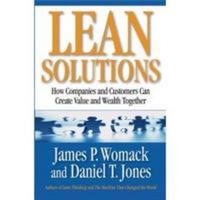Blog posts on customer focusPosts selected fromManagement Blog - Engineering Blog - Investing Blog and other blogs - Interview with Jim Womack (2005)

The whole idea of lean solutions is to start with today’s customer in today’s circumstances and ask what the customer really wants. When we do this, the first thing to note is that manufactured goods have gotten vastly better, somewhat cheaper
...
But we have also noticed for years the growing gap between the factory, where things are getting better, and the situation of providers and consumers where it often appears that things are getting worse.
continue reading: Interview with Jim Womack (2005) - Superior Customer Experiences Start with Respect for Employees
Oakley found that there is a direct link between employee satisfaction and customer satisfaction, and between customer satisfaction and improved financial performance. Employee satisfaction is a key antecedent to employee engagement. He also found that organizations with engaged employees have customers who use their products more, and increased customer usage leads to higher levels of customer satisfaction.
This is not a zero-sum game. Good managers grow the pie so all the stakeholders can get more benefit (customers, investors, employees…). continue reading: Superior Customer Experiences Start with Respect for Employees - Poka-Yoke Assembly
Poka-Yoke (mistake-proofing) is one of my favorite ideas. I just love the idea of not only making something that works well but making something that is difficult to use misuse or use in a way that leads to problems, waste and disappointment. continue reading: Poka-Yoke Assembly - Suggestions to Improve Google (2006)
I have suggested all of these for years and I still want them:
1) Let me chose the type of files searched (exclude pdfs, word, power point..). Then if I can’t find what I want I can expand to include them. At the very least give me some way of making the type much more visible (I realize it is there now but I often click before my mind notices…).
2) Let me remove web sites from my default searches. I would imagine this could even be used to help Google’s normal search results by getting a sense of sites huge numbers of people “block” The same spam sites show up for searches and I would rather block them if Google can’t figure out how to do so.
3) Let me create site search lists, where I create lists of sties I want searched – then I can target my searches how I want. Actually now that rollyo does this... continue reading: Suggestions to Improve Google (2006) - Customer Service is Important
My experience did not give me the impression they were focused much on what was important to me as a customers. The service I received seemed to be what I would expect from a company very focused on the idea that the objective of the company is to increase profits at the expense of everyone else. Two models of organization provide a very different customer experience. One that sees customers as fools to be fleeced seems common among USA arilines, health care providers, cable companies, large banks, car dealers and phone companies. The idea that organizations exists to provide customers value and the company takes a profit for providing that value sadly seem rare in the USA (though some organizations behave this way: Trader Joe's, many credit unions, many small restaurants and Apple (though some may disagree with me placing them here). continue reading: Customer Service is Important - Zero Defects
I do not believe you succeed by declaring your goal to be zero defects. You succeed by creating a culture of never ending improvement, of customer focus, of fact based decision making, of learning, of “empowerment”…
Part of that improvement is reducing variation, reducing defects, implementing smart new mistake proofing but innovation is too. Effectively zero defects is not really achievable in most cases. Defects are largely a matter of definition. As performance improves expectations will often rise. When you eliminate anything you would have called a defect years ago, standards are higher and things that would not have been called defects are no longer acceptable. At some point the system process advances to such a level where zero defects is possible in some cases but in many (say medical care, air transportation, education, computer software, restaurants, government, management consulting, civil engineering, legal services…) I really think it is basically impossible. continue reading: Zero Defects - Quality Customer Focus
Customers expectations change over time. Often what was once enough to delight a customer (remote control for a TV) becomes expected. Once a feature is expected the organization gets no credit for providing it they only risk a negative reaction if they fail to provide it. continue reading: Quality Customer Focus - Good Customer Service Example
Recently I bought a new digital camera, Canon A700. Part of the reason I bought it was I had heard they actually provided customer service – you could call them and they answered and helped (plus they have long practiced good management improvement concepts, in general).
Well I received my camera and I could not open the battery compartment: which was quite frustrating. I tried following the instructions but I couldn’t get it to open. So I tried calling Canon and I got a person on the phone within 30 seconds (there was system to direct me to the right person but it was as speaking the answer to a couple questions).
Within a couple minutes the service person (based in Virginia and a Canon employee, as I understand it) had picked up a Canon A700 and explained how to open the door. continue reading: Good Customer Service Example - Problems with Bonuses
Commission pay and bonus often set up a conflict between what is in the interest of the company and the employee. They lead to bunching of orders around quarterly quotas, deadlines and competitions. They lead salespeople to think their job is to sell whatever pays them the most not to assist the customer. continue reading: Problems with Bonuses - Dell, Reddit and Customer Focus (2006)
I think most of Dell's users do not notice what Dell is doing, exactly. Reddit readers, however, by and large, do, which is one thing that makes reading Reddit fun. I find Reddit's users can point out, not just problems, but the systemic causes of those problems (so they vote up the links that do exactly this).
Most customers might not see the chain leading to their frustration but the do know they don't like that the computer is slow and they have to wade through all sorts of software (much of which they don't need or want). I think the author was exactly right that the source of the problem is Dell's monetary incentive is to get paid to add more and more stuff not to give the users what they need.
...
Mainly I think these critical looks at practices are fun reading, but there is also a management issue to understand. There are many smart people who know how to voice their opinion (and the internet can connect that voice to large numbers of people). In this day and age, if you think your imperial halo with protect you from the masses you had better hope none of these people get a look at what you offer. If you are figuratively naked, they will see, and they will shout that fact from the mountain top. continue reading: Dell, Reddit and Customer Focus (2006) - Quality and Costs
Deming explained that increasing quality decreases costs. Page 3 of Out of the Crisis: Improve Quality –> Costs decrease because of less rework, fewer mistakes, fewer delays…
Like most models this does not explain everything. Achieving some quality desires does cost more. And the article examines how to look at the issue of cost reduction in health care, where the view that higher quality costs more persists to a larger extent than elsewhere. There is significant room in health care for adopting improvement that will improve quality and reduce costs because the systems are so poorly designed they are both increasing costs and decreasing quality over what could be achieved. continue reading: Quality and Costs - Better and Different
The answer, as I see it, is to be better and different (when necessary).
...
if you have to choose one, just being better will work most of the time. The problem is (using an example from Deming, page 9 New Economics) when, for example, carburetors are eliminated by innovation (fuel injectors) no matter how well you make them you are out of business.
Often people mistake Deming’s ideas as only about being better. He stressed not only continual improvement (Kaizen, incremental improvement, SPC) but also innovation. He stressed innovation both in the normal sense of innovating new products for customers and also innovation in managing the organization. continue reading: Better and Different - Companies in Need of Customer Focus
My brother has suggested several times I should arrange for companies to pay me to point out their weaknesses (and suggest improvements). I wish I could get them to do so.
Often 1 interaction with their customer service is enough to provide examples of several systemic weaknesses in how customers are treated. continue reading: Companies in Need of Customer Focus - Edward Tufte’s new book: Beautiful Evidence (2006)
 Beautiful Evidence by Edward Tufte is now available. Beautiful is the right word. Tufte’s books are an example of what can be created when someone truly loves what they do and takes pride in every detail of their work. His books are excellent.
In Beautiful Evidence, Tufte explores how to best display evidence looking at: mapped pictures; sparklines; links and causal arrows; words, numbers and pictures together; the fundamental principles of analytical design; corruption of evidence; and more. continue reading: Edward Tufte’s new book: Beautiful Evidence (2006) - Innovation Example: Farecast (2006)
 Farecast provides data and analysis to those looking to purchase airplane tickets. The graph above shows ticket prices for tickets between Boston and Washington DC over the last 60 days. I have thought for quite some time I need better data to make the best purchase decisions. Farecast seems like a great fit.
The airlines attempt to maximize their profit by changing ticket prices. This pricing model is different than most pricing options I face, normally the price is pretty much set: with the possibility of sale prices. continue reading: Innovation Example: Farecast (2006)
|